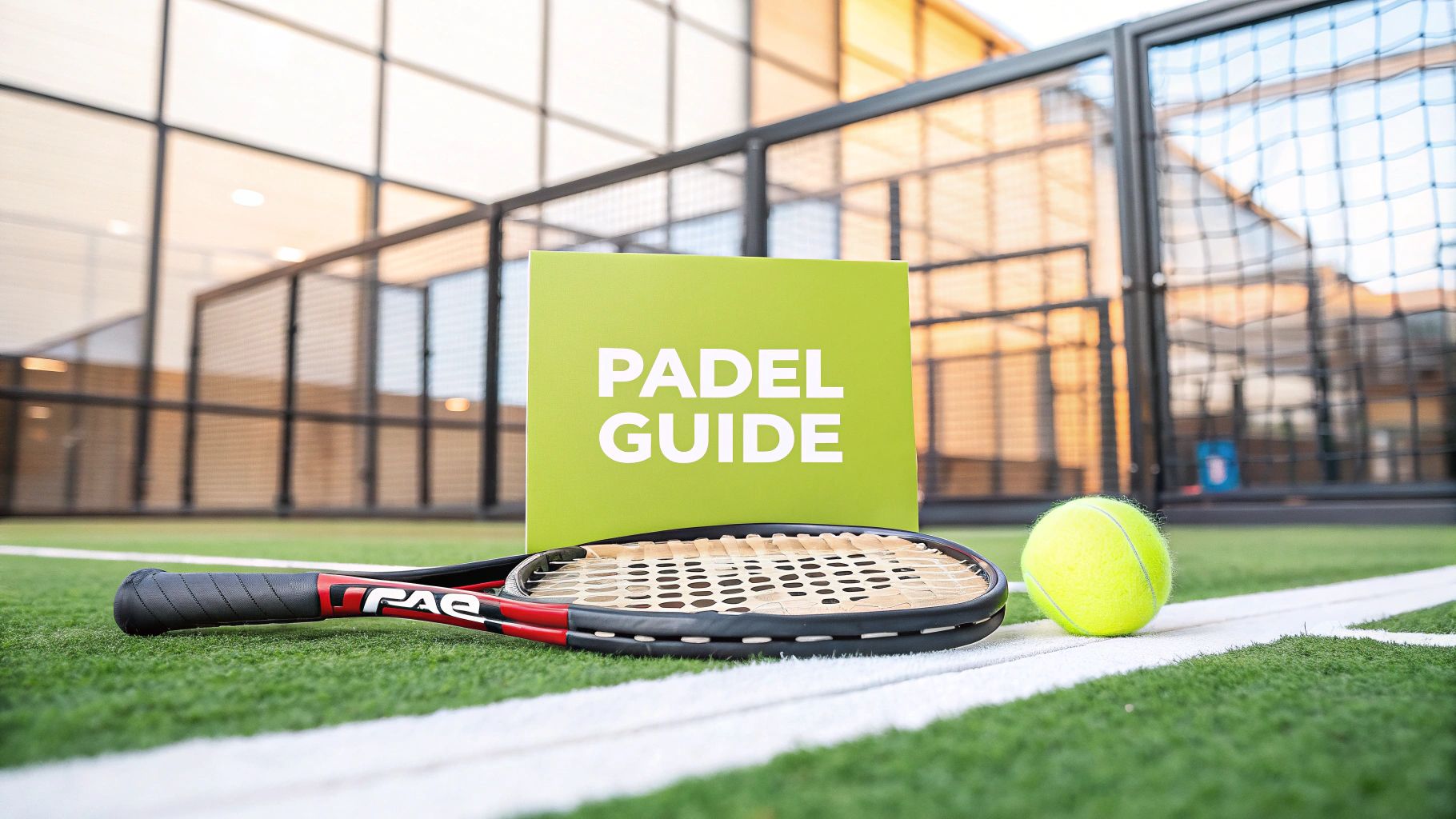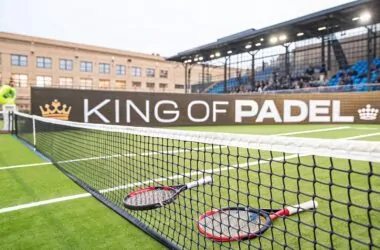The padel racket sport is a fascinating hybrid game, taking some of the best bits from tennis and squash and mixing them together. Imagine a more social, fast-paced version of tennis, played only in doubles on a smaller court completely enclosed by walls that are very much in play.
What Exactly Is the Padel Racket Sport
If you've seen those slick, glass-walled courts popping up in your area, you've stumbled upon the world of padel. It’s a game that’s exploding in popularity for a few simple reasons: it's incredibly easy to get into, the rallies are fast and fun, and the social vibe is a huge part of the appeal.
Unlike tennis, which can feel intimidating for beginners, padel is welcoming from the get-go. The court is more compact, the serve is just a simple underhand bounce, and the solid, stringless rackets are much easier to control.
This setup means even total newcomers can jump on a court and start having legitimate, exciting rallies almost instantly. It’s a game that favors smarts and teamwork over pure power. The walls aren't just boundaries; they're part of your strategy, letting you turn a defensive scramble into a clever offensive shot.
A Game for Everyone
A huge part of padel's charm is that almost anyone can play it. The sport's appeal cuts across all ages and fitness levels.
- Low-Impact Exercise: The court is small and the balls are softer, which means less stress on your joints. It's a fantastic cardio workout without the punishing impact of sports like tennis or running.
- Social Connection: It's a doubles-only game, so you're always on the court with three other people. It's as much about hanging out with friends as it is about winning.
- Easy to Learn, Hard to Master: You can pick up the basics in minutes, but the strategic possibilities are endless. This perfect balance keeps players hooked, always finding new ways to improve.
Padel’s real magic is its simplicity. It gets rid of the tough technical hurdles you find in other racket sports, letting players dive straight into strategy, teamwork, and having a great time from the first hit.
More Than Just a Game
This isn't just a passing trend; the growth of the padel racket sport is a full-blown global movement. There are now over 30 million players worldwide, all building fun, energetic communities around their local clubs. These places often become social hubs for matches, tournaments, and post-game drinks.
The very design of the game encourages communication and partnership, making it a perfect activity for families, friends, or even team-building with colleagues. As you dig deeper, you'll see its appeal goes way beyond the court itself. For a wider look at its incredible rise, you can find more information about the padel sport and its global impact in our detailed coverage. It's a journey into a game that perfectly blends a great workout with a strong sense of community, making every match an experience to remember.
The Unstoppable Global Rise of Padel
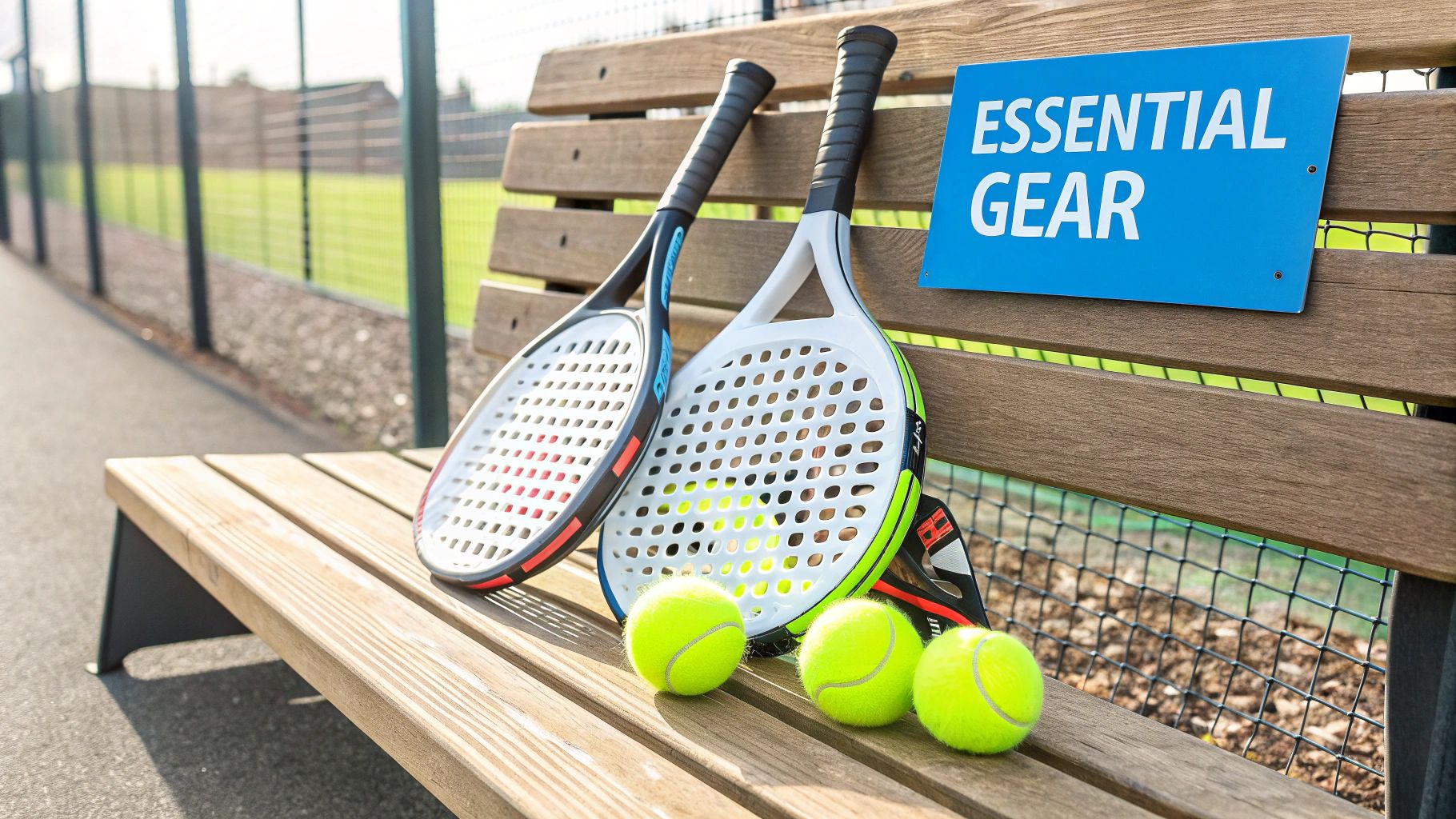
Padel wasn't born in a corporate boardroom or cooked up by a marketing team. Its story is far more interesting, beginning almost by accident in Acapulco, Mexico, back in 1969. Enrique Corcuera wanted to build a tennis court at his home, but he just didn't have the space. His clever workaround was to build a smaller court surrounded by walls—mostly to stop the ball from flying into his neighbor's yard.
He and his friends quickly realized that playing off the walls wasn't a limitation; it was a game-changer. It led to longer, more strategic rallies and created a completely new, incredibly dynamic sport. This happy accident laid the groundwork for a game defined by how easy it is to pick up and how social it is to play.
The game's first big break came when Corcuera's friend, the Spanish Prince Alfonso de Hohenlohe, visited him in Mexico. He was instantly hooked. He brought the idea back to Marbella, Spain, in the early 1970s and built the first two padel courts in the country at the famous Marbella Club. This introduction to Europe's elite gave padel its first taste of the spotlight, but its real explosion was still on the horizon.
The Spanish and Argentine Explosion
Spain and Argentina were the first two countries to truly fall in love with padel, taking it from a niche hobby to a mainstream obsession. Spanish royalty and Argentine tourists who played at the Marbella Club took the game home, and it found incredibly fertile ground.
In both countries, the sport quickly shook off its exclusive, high-society image and caught on with the middle class. Padel clubs started popping up all over, creating tight-knit local communities. This grassroots movement was the key, weaving the padel racket sport into the cultural DNA of both nations.
Padel’s early growth wasn't fueled by big ad budgets. It was pure word-of-mouth. Players were so passionate about how fun and social the game was that they became its best marketers.
This organic spread built a rock-solid foundation. By the 1990s, padel was more than just a fun pastime—it was a legitimate sport with national federations and competitive circuits in Spain and Argentina, setting the stage for it to conquer the rest of the world.
Padel Goes Global
The creation of the International Padel Federation (FIP) in 1991 was a massive step forward. It provided the structure needed to standardize rules and coordinate the sport's growth on a global scale. The FIP started organizing international tournaments, giving padel the credibility it needed to spread to other European countries like Italy, France, and Sweden.
Then came the professional tours, especially the World Padel Tour, which put the sport on TV screens everywhere. Fans could now watch the pros pull off unbelievable shots, turning players into international stars and inspiring a whole new generation to grab a racket. From there, the game's growth has been nothing short of explosive.
Participation has gone through the roof in the last decade alone. Back in 2014, there were about 12 million players globally. Fast forward to 2024, and the International Padel Federation (FIP) reports that number has ballooned to roughly 30 million people playing padel worldwide. That's a 2.5x increase in just ten years. It's not just about numbers, either; the sport is now played in at least 130 countries, a huge jump from 90 countries in 2021. You can dive deeper into these incredible global padel statistics on pala-hack.com.
Today, the momentum is still building, with courts popping up everywhere from the Middle East to North America and Asia. Padel's journey from a single backyard court in Acapulco to a global phenomenon is proof of its universal appeal—it’s a sport that connects millions through community, competition, and just plain fun.
Understanding the Court and How to Play
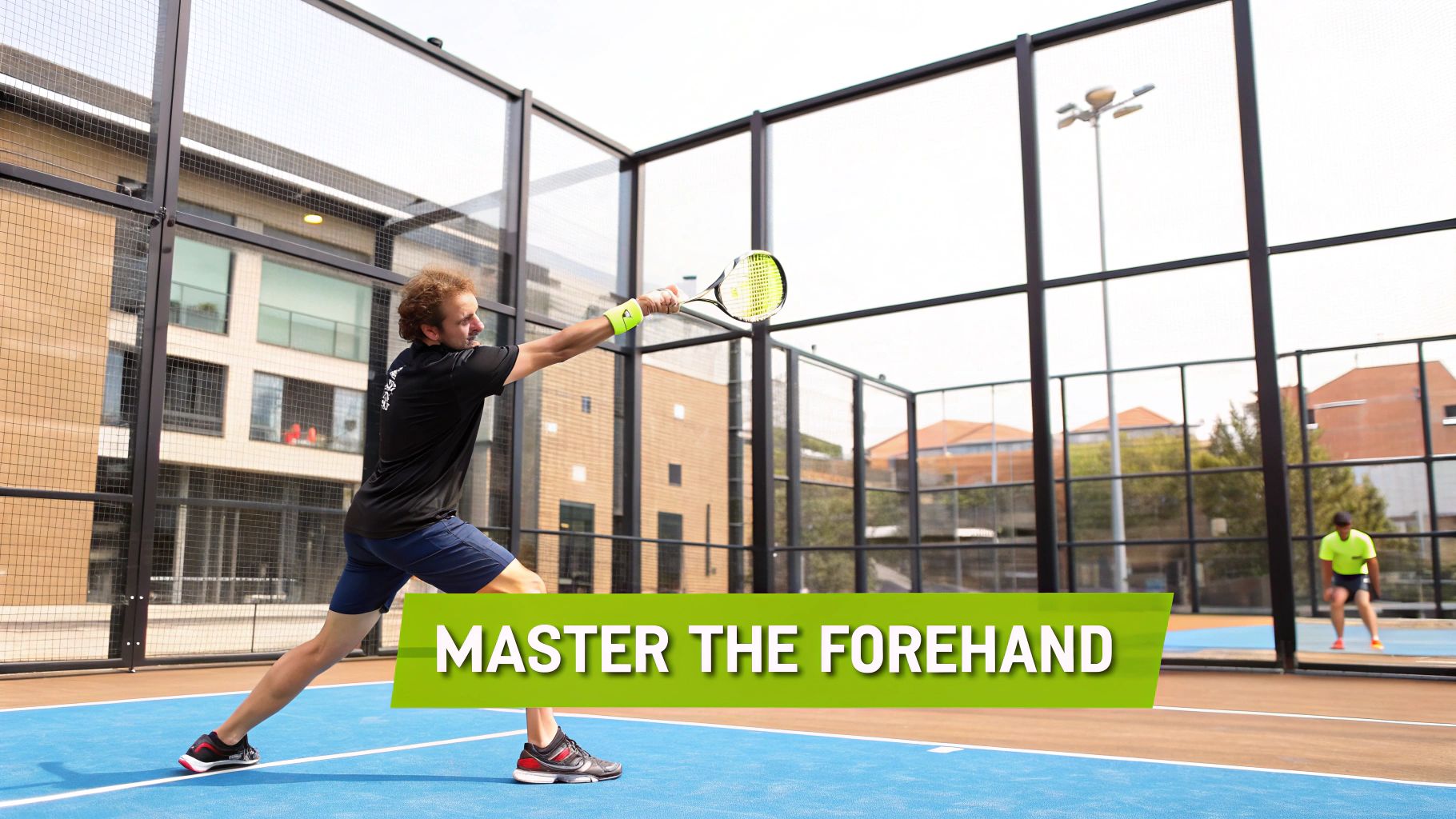
To really get padel, you have to start with its unique playground. At first glance, you might think it's just a shrunken tennis court stuck in a glass box. But that enclosure is the secret sauce—it’s what gives the sport its unique flavor and incredible strategic depth. The walls aren't just there to keep the ball in; they're an active part of the game.
The court itself is a neat rectangle, measuring 20 meters long by 10 meters wide, with a net slicing it in half just like in tennis. This tighter space is a big part of why the sport is so welcoming. There's less ground to cover, so the game is more about sharp reflexes and smart positioning than pure power and lung-busting stamina. It’s the perfect setup for doubles, demanding constant communication and teamwork.
The Court Layout and Key Features
The walls are what truly make padel, well, padel. It's a mix of glass and metallic mesh. The back walls are usually tempered glass standing three meters high, and the side walls are a combination of glass and mesh. This setup is designed for consistent, predictable bounces, turning the walls from a boundary into your best ally.
You can play shots off the walls that would be way out in almost any other racket sport. If a ball bounces once on the ground and then caroms off a wall, it's still live. This creates long, thrilling rallies and forces you to think a few moves ahead. Think of it as a hybrid of tennis and squash, where angles and rebounds are every bit as crucial as a clean forehand.
This design is catching on like wildfire. The demand for courts is exploding, and the numbers are staggering. In 2024 alone, the padel world saw 3,282 new clubs open their doors—that's a huge 26% increase from the previous year. It breaks down to roughly nine new clubs launching every single day. More than 7,000 new courts were built in that time, pushing the global total past 50,000.
Grasping the Core Rules of Padel
While the court is one-of-a-kind, the scoring will be instantly familiar if you've ever watched a tennis match. Padel uses the exact same system: 15, 30, 40, and game. Sets are typically played to six games, and you need to win by two. This shared DNA makes it incredibly easy for tennis players to jump right in.
The serve, however, is where padel rolls out the welcome mat for newcomers. Unlike the complex and powerful overhead serve in tennis, the padel serve is done underhand.
- The Bounce: You have to bounce the ball once on the ground behind the service line.
- The Hit: The ball must be struck at or below waist level.
- The Target: Your serve needs to land in the service box diagonally opposite you.
- Wall Contact: It’s a fault if the ball hits the mesh fence after bouncing in the box. Hitting the glass wall, however, is totally fine.
This simple, easy-to-learn serve removes one of the biggest hurdles in racket sports. New players can confidently start rallies from their very first game without spending weeks just trying to get the ball in.
The underhand serve is a game-changer for accessibility. It levels the playing field, making the start of every point about placement and strategy, not overwhelming power, which is a key reason the sport is so easy to pick up.
Understanding Rally Dynamics
Once the serve is in, the real magic begins. During a rally, the ball has to bounce on your opponent's side of the court before it can touch a wall. After that first bounce, you can either hit it straight back over the net or let it rebound off one or more walls before you make your return.
This "play-it-off-the-wall" rule opens up a world of strategic possibilities. A shot that looks like a clear winner can be saved by playing the rebound off the back glass. It's a constant chess match where you and your partner use the court's geometry to outmaneuver the other team. For a deeper dive, check out our guide on how to play padel which breaks it all down.
You lose the point if the ball bounces twice on your side, if you hit it into the net, or if you smash the ball directly into an opponent's wall without it bouncing on their court first. These simple rules create a game that's easy to follow but has endless tactical layers to master.
Choosing Your Essential Padel Gear
Getting the right gear is your first step to victory on the padel court, and thankfully, it's a lot simpler than you might think. Unlike some sports that demand a whole closet full of equipment, padel really boils down to a few core items that make a huge difference in your game. A smart investment in the right racket, balls, and shoes will have you playing better from your very first match.
The heart and soul of your setup is the racket, which is a completely different beast compared to its tennis or squash cousins. The first thing you'll notice is the lack of strings. Instead, a padel racket has a solid, perforated face made from materials like fiberglass or carbon fiber, wrapped around a soft foam or EVA rubber core. This unique construction gives you an incredible feel for the ball and makes the racket surprisingly forgiving.
This infographic breaks down some of the key differences you'll find in the equipment and court dimensions between padel and tennis.
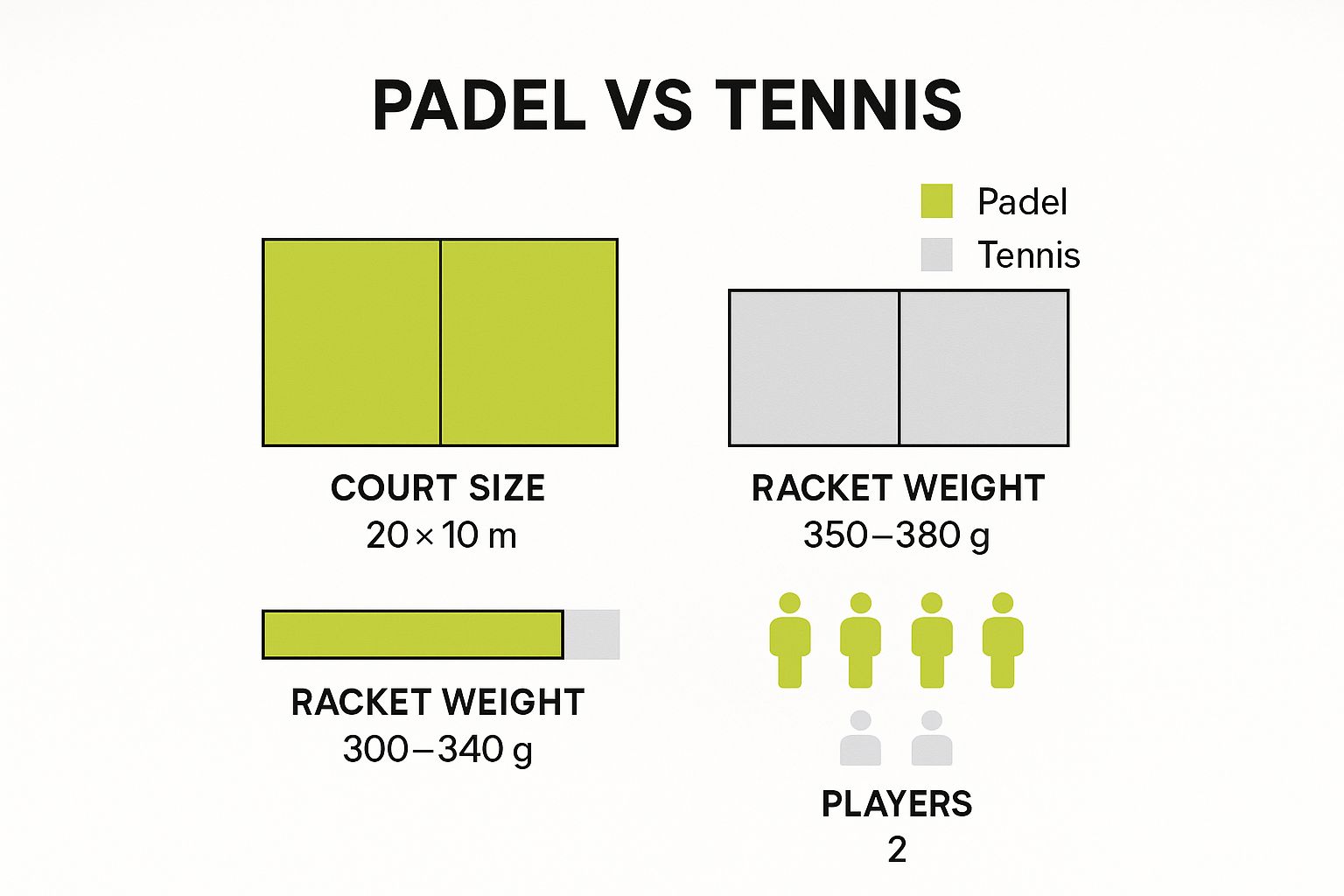
As you can see, the smaller court and doubles-only format are huge reasons why padel is such an accessible and social sport.
Finding Your Perfect Racket Shape
Padel rackets generally come in three main shapes, and each one is built to support a specific style of play. Figuring out these shapes is the key to finding a racket that feels less like a tool and more like an extension of your arm. For a much deeper dive, our comprehensive guide to padel rackets explores all the options in great detail.
Picking the right shape is crucial. It dictates how the racket feels, how much power you can generate, and how much control you have over your shots.
| Shape | Best For | Main Advantage | Sweet Spot Location |
|---|---|---|---|
| Round | Beginners & Control Players | Maximum Control & Forgiveness | Large, in the center |
| Teardrop | Intermediate & All-rounders | Balanced Power & Control | Slightly above center |
| Diamond | Advanced & Power Hitters | Maximum Power | High, near the top |
Ultimately, your first racket should be a learning tool. Starting with a round shape helps you build a solid foundation by prioritizing control and consistency. Once you've got the basics down, then you can start thinking about chasing more power.
This specialized gear is part of a booming industry. The global padel sports market is on track to hit around $228.7 million by 2025, and it’s expected to grow at a Compound Annual Growth Rate (CAGR) of 7.2% all the way through 2033. This explosion is being driven by more and more people picking up the sport and some serious advancements in racket technology.
Padel Balls and Proper Footwear
It’s tempting to think any old tennis ball will work, but padel balls are actually engineered specifically for the sport. They look pretty much identical, but they have slightly less internal pressure. It's a subtle difference that has a massive impact on the game—the balls bounce lower and slower, giving you more time to get into position and leading to those epic, long rallies padel is famous for.
Last but not least, let's talk about your connection to the ground: your shoes. Padel is played on artificial turf, which is often lightly dusted with sand to help with moisture and play speed. The best padel shoes feature a herringbone or omni-court sole pattern. This design gives you the perfect mix of grip for those sharp stops and pivots, while still letting you slide into a shot when you need to.
Whatever you do, don't wear running shoes. Their aggressive grip is a recipe for disaster on a padel court and can easily lead to a twisted ankle or knee. A good pair of padel-specific shoes isn't just about performance; it's about protecting yourself and moving with confidence.
Mastering the Fundamental Shots and Tactics
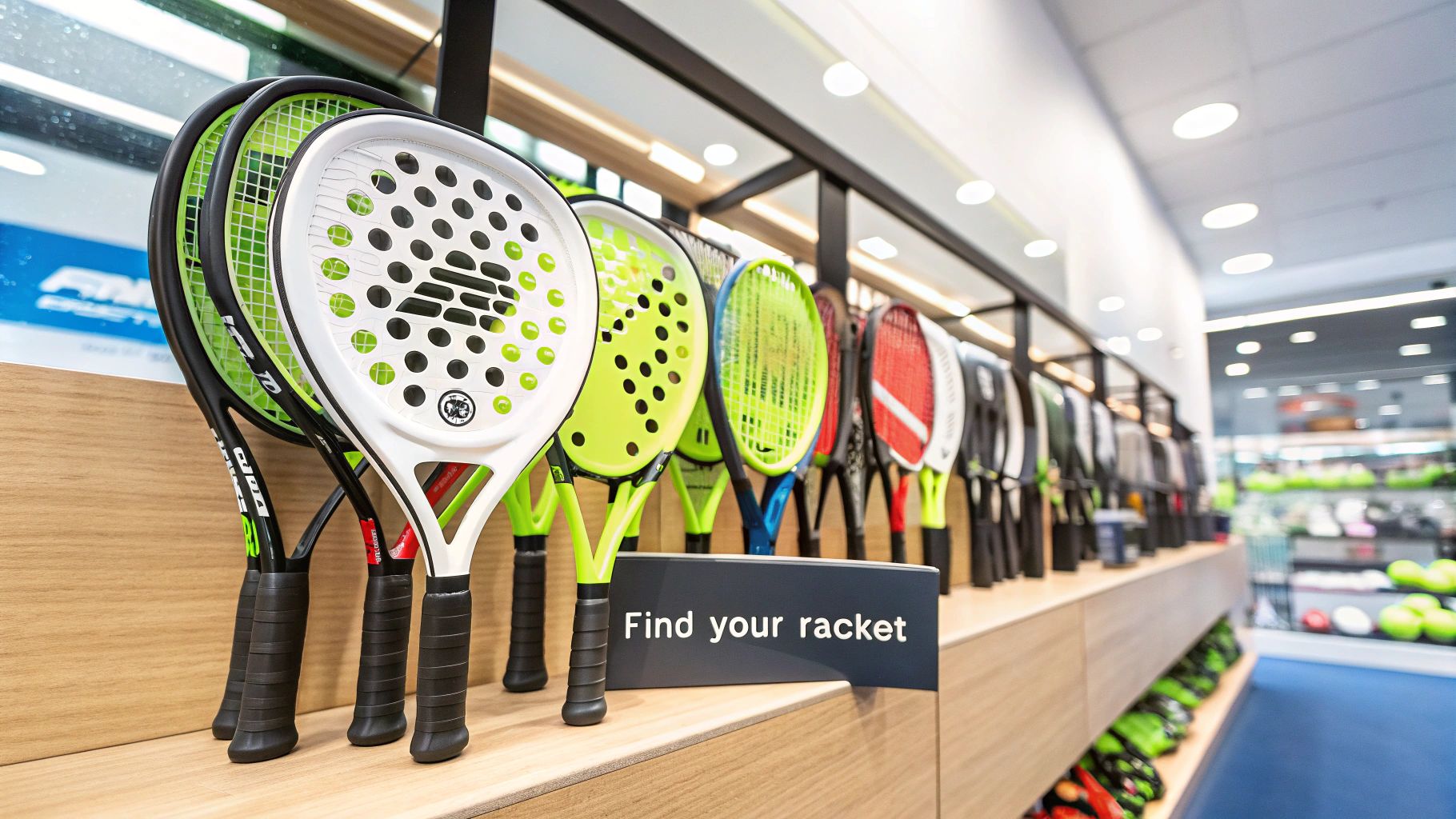
Alright, you've got the gear. Now it's time to learn the language of the court—the essential shots that are the building blocks of every single rally. Think of padel as a conversation between four players. Learning these core techniques is like learning the vocabulary you need to express yourself, whether you're defending deep in your own corner or attacking at the net.
The great thing about the padel racket sport is that the basic shots feel pretty natural. You can build a solid foundation much faster than in other racket sports, which often have a seriously steep learning curve. Once you've got the basics down, you can start layering in the more advanced shots that make padel so incredibly strategic and fun.
Building Your Foundation With Groundstrokes
Everything starts with solid groundstrokes—your forehand and backhand. These are your bread-and-butter shots, the ones you’ll use constantly to control the pace of the point and set up your next attack. The trick is to keep your swing compact and controlled. You don't need a massive wind-up; just let the racket's foam core do the work for you.
Forget the big, loopy swing you see in tennis. Think of it more like a firm, controlled push through the ball. Consistency will always beat raw power here. A well-placed shot that stays low is almost always a better choice than a risky, hard-hit ball that might fly out.
From the back of the court, you'll move to the net for the volley. In padel, whoever controls the net usually controls the point, and the volley is your number one tool for the job. You'll want to use short, punchy blocking motions to send the ball deep into your opponent's court, keeping them scrambling on defense.
Introducing Padel-Specific Overheads
This is where the game gets really interesting and starts to separate itself from tennis. While tennis really only has one main overhead smash, padel has several different types, and each one has a very specific job. If you want to control the game from the front of the court, you have to master them.
The two you absolutely need to know are the bandeja and the vibora.
- The Bandeja (The "Tray"): This is your defensive workhorse. When your opponents lob the ball high over your head, you hit the bandeja. It's a sliced shot designed to go deep, stay low after bouncing off the glass, and give your team time to get back into position at the net. You're not trying to win the point with it; you're trying to reset the point.
- The Vibora (The "Viper"): This is the bandeja's aggressive cousin. The vibora is also a slice, but you hit it with more speed and a nasty side-spin. The goal is to make the ball "bite" off the side glass, skidding away from your opponent unpredictably. You use this shot to pile on the pressure and force a weak return.
The bandeja is about buying time and holding your ground. The vibora is about turning a defensive situation into an immediate threat. Knowing when to use each is a sign of a smart padel player.
Getting the feel for when to hit a bandeja versus a vibora is a game-changer. A well-played bandeja keeps you in the point, but a perfectly timed vibora can end it.
Using the Walls as Your Ally
This is probably the biggest mental hurdle for new players, especially those coming from tennis. In most racket sports, when a ball is flying toward the back wall, the point is over. In padel, it’s just getting started. Learning to let the ball rebound off the back or side glass gives you precious extra time to set up your shot and turn a defensive scramble into an offensive opportunity.
A classic tactic is the "salida de pared" (wall exit). You let the ball hit the back glass, take a step back to create space, and then hit a controlled shot back over the net. This one move can completely neutralize a powerful smash from your opponent and reset the rally in your favor.
Finally, never forget that padel is a doubles game through and through. You have to be talking to your partner constantly about who's taking which ball. Good court positioning means moving together like you're tied by a rope, covering the middle, and working as a unit to own the net. A strong partnership will beat two talented but silent individuals every single time. Mastering these elements is what turns you from someone just hitting a ball into a true padel strategist.
Your Padel Questions Answered
Jumping into a new sport always comes with a few questions, and padel is no exception. To get you on the court faster and with more confidence, we've pulled together answers to some of the most common things new players ask.
Is Padel Easier to Learn Than Tennis?
For almost everyone, the answer is a resounding yes. Padel is much friendlier for beginners than tennis. The court is smaller, so you aren't covering nearly as much ground. The serve is underhand, which is a breeze to get the hang of, and the solid racket is way more forgiving when you don't hit the ball perfectly dead-center.
But the real secret sauce? The walls. They keep the ball in play so much longer than in tennis, which means you get to enjoy fun, satisfying rallies right from your very first game. You'll spend less time chasing down missed shots and more time actually hitting the ball, which is a massive win for anyone just starting out.
Do You Need a Partner to Play Padel?
Padel was born to be a doubles game. A proper match is always played with four people, two on each team. You can absolutely hit the ball against a wall by yourself or run drills with a friend, but the real heart of the sport—the strategy, the teamwork, the fun—truly comes alive in that two-on-two format.
Don't have a crew of three other people on standby? No problem. Most padel clubs and sports apps like Playtomic have match-making features built right in. They make it super easy to connect with other players around your skill level and hop into a game.
How Is a Padel Racket Different From a Pickleball Paddle?
At a glance, they might look similar because both have solid faces, but they're engineered for completely different sports. The differences are pretty significant.
- Thickness and Core: A padel racket is much beefier, usually 38mm thick, with a soft foam or EVA rubber core inside. Pickleball paddles are thin and light, built with a honeycomb polymer core.
- Surface: Padel rackets have holes drilled right through the face. This isn't just for looks; it helps cut down on air resistance so you can swing faster and helps you put some wicked spin on the ball. Pickleball paddles have a completely solid, smooth surface.
These aren't just random design choices. Every detail is fine-tuned for the ball, court, and physics of each specific game. A padel racket is designed for powerful shots and crazy rebounds off the glass, while a pickleball paddle is built for the quick, dinking exchanges you see in its sport.
At Padel Rumors, we've got all the resources you need to get into the game, from deep-dive gear reviews to the latest news from the pro tours. Check out our guides and find everything you need for your padel journey at https://www.padelrumors.com.





